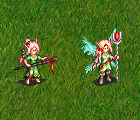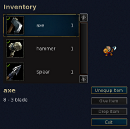Wesnoth UMC Review: Shadows of Deception
For very long, there have been only two (2) campaigns in the Wesnoth add-ons server that follow the “shadowmcanon” established by Invasion from the Unknown and After the Storm; the campaigns in question are Invasion from the Unknown, and After the Storm. Yes. That’s it. The only other campaign whose author has consulted plot matters with me and followed the shadowmcanon correctly (as opposed to blindly extrapolating from IftU and AtS and making grossly wrong assumptions about things that are left unspecified or presented in a deliberately vague fashion) is The Silver Lands, but it was abandoned far too early during its development cycle.
But the status quo has just changed with the release of version 0.5.0 of Shadows of Deception (NX-RPG), a campaign by vultraz for Wesnoth 1.11.6 and later. So far, six scenarios out of the first set of 12 have been done; the goal is two episodes.
Of note is the fact that vultraz has been a member of my After the Storm internal playtesting and prose reviewing team for a couple of years.
Per the description found in the campaign’s forum thread, Shadows of Deception (SoD for short) is “a half-RPG, half regular style Wesnoth campaign, incorporating several custom gameplay elements as well as your typical battle scenarios”. What does half-RPG mean? Damn if I know — I don't even know what a full RPG would be. Having playtested SoD prior to the release myself, though, I can say that the campaign places a fair amount of emphasis on the story while experimenting with some unusual gameplay mechanics.
The story

The protagonists of this campaign are the elvish enchantress Niryone, and her apprentice Elynia. If you have played IftU or AtS, you are definitely familiarized with Elynia’s game-breaking abilities and power. You will not find any of that here. SoD is a distant prequel that takes place during her apprenticeship days circa 1081 YW, back when she was far even more useless younger and entirely ignorant of the sequence of events that would lead to Wesnoth’s political reorganization and changes echoing throughout all of the Great Continent. Thus, the real protagonist for most of SoD Episode I is her adoptive mother and mentor Niryone, whose existence was repeatedly alluded to throughout AtS.
The story is derived from Late History: Irdya before the Fall on the wiki (full of SPOILERS, in case it isn’t obvious), which I originally wrote back in 2008 (and revised some months ago) along with the rest of Future History in order to provide additional backstory for some IftU characters (e.g. Elynia, Argan) and events (e.g. the Fall). But what I wrote back then was not quite the story narrated by SoD; my text was essentially limited to an overall outline enumerating major events and characters in the broader context of Irdya. All characters and events in SoD are written according to vultraz’s own interpretation of the outline, with some input from 8680, Zerovirus, and me. In that regard, for characters other than Elynia’s younger self, I have only provided very rough characterization guidelines without going into details that could constrain the creative process too much. Elynia’s interpretation is purely vultraz’s, and so far I’d say he has nailed her character.
Without going into too much detail about the plot, I think that it features some unique ideas that I haven’t seen used a lot in any mainline campaigns — or IftU and AtS, for that matter. The great thing about the campaign is that it stands on its own as a product, and you don’t need to play any other campaigns to understand what’s going on. Of course, knowing some mainline lore always helps when it comes to identifying locations such as Wesnoth and Elensefar, but in the worst case you’ve got a massive map of the “mainline region” of the Great Continent in the game’s titlescreen.
The gameplay


To elaborate upon my previous statement about SoD’s design, resources throughout the campaign are rather limited, thus you won’t be building a massive army like those seen in Northern Rebirth or classic IftU — unless your intention is to repeatedly run into inconvenient negative budget situations. Au contraire, your focus should be on managing as few units as possible and utilizing the spells mechanic with your two leads. Disappointingly, this first release of the campaign only implements one (1) spell for Niryone, and a secret spell hidden somewhere decidedly secret. Your starting spell, however, should be quite useful to get your units out of sticky situations; in fact, it can be so useful, it borders on being a game-breaking mechanic, an issue which should hopefully be corrected in upcoming releases along with the overall lack of spells. On the plus side, this is better connected to the story than your typical Wesnoth UMC gameplay gimmick, as illustrated soon enough during the first few scenarios. The same can be said for the inventory mechanic; it is not particularly useful due to the current items shortage, but it does come into play for advancing the storyline at one point so far.
Perhaps more important than how often these features are used throughout the campaign in its current state, is the fact that the author has clearly put a lot of thought and effort into them. Both make use of custom Lua-based GUI2 dialogs, a Wesnoth engine feature that is very poorly documented and quite sadly underrated, even by the GUI2 developer himself. The UI design done for the sake of these two gameplay aspects alone makes the campaign fit seamlessly within Wesnoth’s framework, a courageous feat to behold and respect given GUI2’s status as an undermaintained and eternally moving target. That said, much like AtS’ (very sparse) usage of the GUI2 Lua bindings, it is quite probable that this kind of thing will break for users on display resolutions lower than the minimum supported by mainline, which is 800x480 absolute (not Retina) pixels. For now this isn’t a problem, since there are no unofficial ports of 1.11.x to mobile devices, and maybe by the point Wesnoth 1.12 is out everyone will be on devices with 8K full-HD or whatever. Yes, that’s a hyperbolic statement about 1.12’s unending development cycle, in case you could not tell.
Visuals, units, et cetera
Map design in SoD is generally good, portraying lush detailed environments from the Great Continent as it was during the mainline epoch, as opposed to the ruined wastelands seen so often in IftU or AtS. However, they are interspersed with underground scenarios, which may be somewhat of a letdown for those who dread dungeon crawling-style gameplay in the style of the aforementioned campaigns. To make up for it, SoD also features varied recruits and new enemy units to break the constant destroy-all-undead-and-kill-all-orcs cliché seen in so many, many other campaigns.
The art for the two protagonists was provided by some random nobody, who I have heard was basically forced by vultraz to make sprites within exceedingly restrictive schedules to the point that he or she had to sacrifice quality for the sake of getting a releasable product in time. I have also heard that this situation has become kind of a chronic issue for that person.
Some of the new unit art that features in later scenarios was provided by everyone’s favorite prolific pixel artist, Zerovirus. I am fairly sure Zerovirus fans will be able to spot his art as soon as it begins appearing on the game map, but it’s important to note that some of the art was actually created or edited by vultraz as well.
Other than these few points, there is not much else to talk about regarding SoD’s art development. Much like AtS, which was started and finished with a budget of exactly $0.00, portrait art for original characters is completely absent in this campaign. Nothing that can be helped in the short term, given that the author doesn’t work with portrait artists at this time, and seriously, good portrait artists generally don’t have much time to spare and would only be willing to contribute under commission, reasonably so.
To conclude
vultraz’s Shadows of Deception is a bold attempt to develop a product that can join the shadowmcanon (IftU and AtS) while working as its own campaign without requiring the player to be familiarized with the rest. It is an early work in progress with only six scenarios complete out of 12 for the first episode, but it already shows a huge amount of dedication on part of the author in all areas that make up a good Wesnoth campaign: art, story, map design, you name it. Some of the new gameplay aspects introduced aren’t used as much as they should probably be to make them enticing to newcomers, but this situation may change as time passes and player feedback is provided. Because, you are obviously going to provide the author with that precious feedback while the add-on is being developed, right?
I think it is a promising campaign. I for one am eagerly looking forward to playing the rest, assuming it doesn’t get abandoned like the aforementioned case of TSL. That would make me sad. And nobody wants to see a sad shadowm.